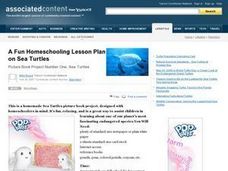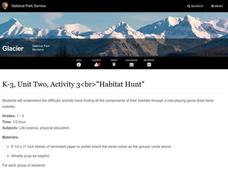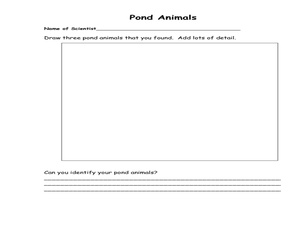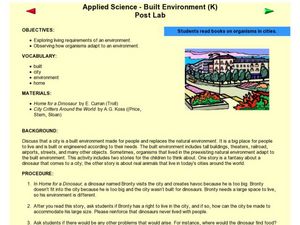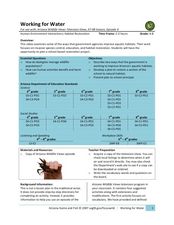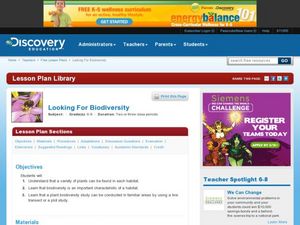Curated OER
Homeschooling Lesson: Sea Turtles
Students write down the names of common turtles and observe pictures of various types. In this sea turtles lesson plan, students review names and features of these animals, label and draw a picture. Students research habitat, migration,...
Curated OER
Norman Suburban Activity
Students analyze the factors affecting organisms in the pond ecosystem. In this environmental science instructional activity, students perform an experiment to determine pH, nutrients and temperature of different pond sites. They present...
Curated OER
Habitat Hunt
Students discover how hard it is for animals to find all the items needed in their habitat. In this habitat lesson plan, students play a game in which they pretend to be an animal, they discover that not all animals can find the food...
Curated OER
Mighty Macroinvertebrates
Seventh graders identify the names and features of macroinvertebrates found in Turtle River. In this ecology lesson students use digital microscopes and take pictures of invertebrates.
Curated OER
Habitat Hopscotch
Learners analyze different habitats. For this habitat lesson, students evaluate what animals need in their habitats. Learners participate in the game Habitat Hopscotch.
Curated OER
Water Snails
Students study water snails. In this water snails lesson plan, students research the habitats of water snails. After conducting research, students investigate water snails in their habitats and generate scientific observations.
Curated OER
Pond and Pond Organisms
Learners explore pond ecosystems. In this pond organism activity, students will use pond water and a plastic bad in order to locate and identify freshwater organisms. The activity is designed for younger grades, but...
Curated OER
Organisms In Cities
Students explore environments and how organisms adapt to the environment. In this science lesson, students read a story and discuss how animals have adapted to changes in their environment.
Curated OER
Assessing the quality of habitat for Monarch Butterflies
Students use different sampling methods to determine the population size and appropriate space for monarch butterflies. In this averages lesson plan, students complete word problems where they can accurately estimate the size of an...
Curated OER
Working for Water
Students examine the ways that government works to help improve aquatic habitats. In this water habitats lesson students view a video and plan a school restoration project.
Curated OER
Easy as Pi
Students describe the importance of structural features that increase surface area in a coral reef habitat. In this investigative lesson students quantify the impact of modifications on surface area in model habitats.
Curated OER
Easy as Pi
Students examine structural features. In this life science lesson students complete an activity and quantify the impact of various modifications.
Curated OER
Who's New in the Deep Sea?
Young scholars examine the methods and technology that scientists use to study the deep sea and other remote environments. In this ocean habitats lesson students make observations about organisms from video clips, generate...
Curated OER
Management of Commercial Fisheries, Part 2
Students examine the differences between the past vs. the present fishing and the uses of fisheries. For this investigative lesson students complete a worksheet and learn to think critically in order to protect our environment.
Curated OER
The Turkey Web
Students identify habitat and feeding habits of the wild turkey. In habitat and diet lesson students view a demonstration, complete an activity then follow turkey sign.
Curated OER
Biomes: Freshwater & Seawater
Students observe organisms behavior and adaptations. In this biomes lesson plan students conduct fieldwork to determine water quality and answer questions about the differences between different habitats.
Curated OER
Understanding Interactions Among Local Species and the Local Environment
Students examine the differences between biotic and abiotic factors, explain the difference between habitat and niche and compare how organisms get their nutritional needs. In this local environment lesson students trace the path...
Curated OER
Let's Go to the Video Tape!
Students examine biological diversity and see how it relates to the concepts of variety and relative abundance. In this investigative lesson students view a video on biodiversity and complete an activity.
Curated OER
Blue Planet: Open Ocean
Students research facts about animal species. For this ocean lesson students view a video, prepare illustrated cards and create a food-web display.
Curated OER
Entering the Twilight Zone
Pupils describe major features of cold seep communities and list organisms that are found in these communities. In this water habitat instructional activity students examine trophic levels, describe the process of...
Curated OER
Wildlife Habitat
Students examine habitats and describe their elements. In this wildlife habitat lesson students study the factors that affect habitat and write a short report.
Curated OER
Looking for Biodiversity
Students explore habitats and see that there are a variety of plants that can be found and that biodiversity is an important characteristic. In this biodiversity lesson students complete an activity that explains how to perform a...
Curated OER
Chewin' in the Chesapeake
Students examine a web page on food webs and select a habitat to research. In this research instructional activity students identify the organisms found in the food web and present their findings to the class.
Curated OER
Feeding in the Flow
High schoolers examine current flow and describe ways in which it may effect food of reef building corals. In this coral lesson students identify two environmental factors that may affect the morphology.


